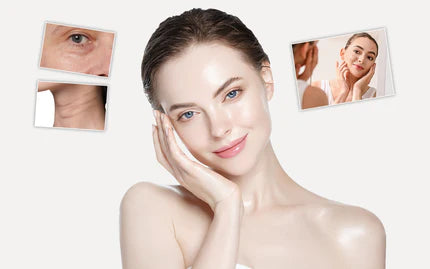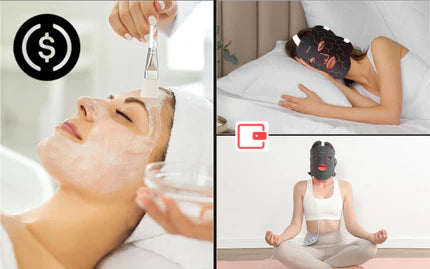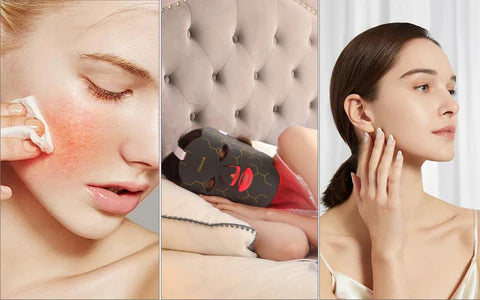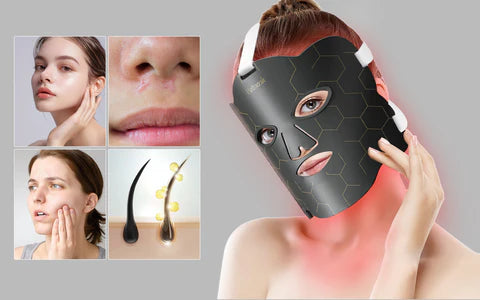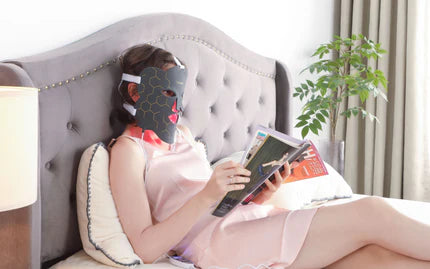Facial skin care has taken a leap forward with treatments like IPL (Intense Pulsed Light) and LED Red Light Therapy, offering a glow-up without surgery. These popular therapies each claim to smooth wrinkles, fade spots, and clear acne scars gently. In this article, we'll compare IPL and LED red light therapy, looking at their benefits, risks, costs, and how to choose the right one for you. If you're curious about easy, effective ways to keep your skin looking young and healthy, read on for insights into these leading light-based treatments.

Quick Comparison Sheet
| Feature | IPL (Intense Pulsed Light) | LED Red Light Therapy |
| What It Does | Uses broad-spectrum light to target pigmentation, redness, and hair removal. | Uses red light to stimulate collagen and heal the skin. |
| How It Works | Light energy absorbed by pigment in the skin converts to heat, destroying target cells. | Red light penetrates skin, promoting repair and reducing inflammation. |
| Spectrum of Light | Broad-spectrum light from about 500 nm to 1200 nm, adjustable filters. | Narrow-spectrum red light, typically around 630-700 nm, up to near-infrared at 850 nm. |
| Treatment Experience |
- In-office procedures - 20-60 minutes per session - Might feel like a snapping sensation |
- Can be done at home or in-office - 10-20 minutes per session - Pain-free and relaxing |
| Post-Treatment | Possible redness or tenderness; avoid sun exposure. | No discomfort; no downtime required. |
| Effectiveness | Good for reducing dark spots, visible blood vessels, and hair removal. | Best for anti-aging benefits and reducing inflammation. |
| Risks | Mild to moderate side effects like redness, swelling, bruising. | Very few risks, gentle on all skin types. |
| Cost | $300-$600 per session; multiple sessions needed. | $30-$400 for devices; $50-$200 per professional session. |
| Skin Suitability | Preferably lighter skin tones due to targeting pigment. | Suitable for all skin types, including sensitive skin. |
| Lifestyle Consideration | Requires clinic visits and sun avoidance. | At-home convenience; integrates easily into daily routines. |
| Ideal For | People targeting specific pigmentation issues or unwanted hair. | Those seeking regular anti-aging treatment with minimal fuss. |
What is IPL?
Intense Pulsed Light, or IPL, is a technology that uses flashes of broad-spectrum light to treat various skin conditions. Unlike a laser, which directs a single wavelength of light energy at the skin, IPL releases light of multiple wavelengths. IPL is particularly effective for reducing the appearance of sun spots, age spots, facial redness, and visible blood vessels. Additionally, it can be used for hair removal.
What is LED Red Light Therapy?
LED Red Light Therapy uses specific wavelengths of red light produced by LEDs (Light Emitting Diodes) to penetrate the facial skin. Unlike IPL, this therapy targets skin cells with low-level wavelengths of light, which doesn't cause harm or discomfort. This type of therapy is commonly used to minimize the signs of aging, such as wrinkles and fine lines, to reduce inflammation, and to promote healing, making it beneficial for those looking to enhance their complexion's texture and firmness.

Understanding the Spectrum: IPL vs. LED Red Light
When choosing a skin treatment, it's helpful to understand the type of light each therapy uses, as this affects how they work on your face. Here's a breakdown:
IPL (Intense Pulsed Light)
- Type of Light: Broad-spectrum visible light, along with some infrared light.
- Spectrum Range: Wide range of wavelengths from about 500 nm up to 1200 nm.
- Targeting Method: Filters adjust the spectrum to target facial skin concerns by absorbing pigment (color) in the skin, such as dark spots and hair.
- Penetration Depth: Different wavelengths reach various depths of the skin, which can be controlled to target specific issues.
LED Red Light Therapy
- Type of Light: Narrow-spectrum light, primarily red light.
- Spectrum Range: Specific wavelengths within the red light spectrum, usually around 630 nm to 700 nm, sometimes extending into near-infrared at 850 nm.
- Targeting Method: Directs precise wavelengths to stimulate cellular repair and increase circulation without targeting pigment.
- Penetration Depth: The specific wavelengths penetrate different layers of facial skin but are generally absorbed within the first few millimeters.
IPL's wider spectrum allows for versatile treatments tailored to specific skin issues, whereas LED’s focused approach offers a gentle means to enhance overall skin health and support anti-aging.
What to Expect: Treatment Processes and Experiences
IPL Treatment Procedure
If you're considering an Intense Pulsed Light (IPL) session, here's what typically happens:
- Consultation: Before the actual treatment, you’ll likely have a consultation with a skincare professional to discuss your goals and determine if IPL is right for you.
- Preparation: On the day of the treatment, your facial skin will be cleaned, and you might be given protective eyewear. A cooling gel is often applied to the area being treated to minimize discomfort and enhance the light's penetration.
- Treatment: The IPL device is adjusted to the correct settings based on your skin type and condition. During the session, you'll feel a snapping sensation as the pulses of light are emitted onto your skin. The duration of the procedure varies but can range from 20 minutes to an hour, depending on the treatment area.
- Post-Treatment: Immediately after the session, a cooling pack or gel may be applied to soothe any discomfort. Your skin may look red or feel a bit tender, like a sunburn, but this usually subsides within a few hours to a few days.
- Recovery: There’s generally no significant downtime with IPL, and you can return to most of your regular activities right away, though it’s advised to avoid direct sunlight and to use sunscreen.
LED Red Light Therapy Session
LED Red Light Therapy is known for being gentle and non-invasive. Here’s the usual process:
- Consultation: Similar to IPL, you'll start with a consultation to ensure LED therapy such as the Black suits your facial skin concerns.
- Preparation: You don't have to do much to get ready, but make sure your skin is clean and free from makeup or lotions before you start. Protective eyewear isn't necessary, as LED light isn’t harmful to the eyes.
- Treatment: With a red light therapy mask, you can give your skin a treat while doing other things, like chilling out or catching up on your favorite book. If you need to focus on a specific spot or want to cover a larger area, you can use a handheld device or a bigger light panel. Regardless of the device, these sessions are pain-free and swift, usually lasting just 10 to 20 minutes—conveniently fitting into even the busiest schedules and offering a more flexible routine compared to IPL treatments.
- Post-Treatment: After the session, there's no immediate need for cooling or soothing agents, as the treatment doesn’t cause heat damage or discomfort.
- Recovery: One of the advantages of LED therapy is that there's no recovery time is required. You can carry on with your day right after the treatment. It’s also safe to apply skincare products and makeup immediately afterward if desired.
Both treatments are straightforward and involve minimal discomfort. However, it's always important to follow the specific advice given by your skincare provider, as individual experiences and protocols can vary.
Effectiveness for Common Skin Concerns
When it comes to enhancing facial skin and addressing common concerns, both IPL and LED Red Light Therapy offer valuable benefits. Here's a closer look:
| Treatment | Concerns Addressed | Effectiveness | Sessions Needed | User Experience |
| IPL (Intense Pulsed Light) | Dark spots, visible redness, fine lines | Highly effective for diminishing dark patches and reducing the visibility of blood vessels; promotes clearer, more evenly toned skin. | Typically 3-5 treatments for optimal results. | Favored for its ability to rejuvenate the skin, leading to a younger, healthier appearance. |
| LED Red Light Therapy | Wrinkles, skin firmness, inflammation, acne | Known for stimulating collagen production, resulting in smoother, tighter skin; soothes inflammation and aids in healing acne scars. | Regular sessions as part of a skincare routine. | Cherished for its gentle nature, making it suitable for daily use without downtime, gradually improving skin texture and firmness. |
While IPL might require a small series of treatments to achieve peak results, LED therapy can be incorporated into regular skincare routines for ongoing maintenance and gradual enhancement.
Side Effects and Risks
Is IPL Safe? A Look at Possible Risks
Intense Pulsed Light (IPL) therapy is generally safe when performed by a qualified professional, but like any skin treatment, it comes with potential side effects. Some people may experience mild redness, swelling, or discomfort in the treated area, similar to a sunburn sensation, which typically subsides within a few days. Less commonly, IPL can cause bruising, blistering, changes in skin color, or infection if the treated area isn't properly cared for post-session. To minimize these risks, it's important to follow pre- and post-treatment instructions like avoiding sun exposure, using sunscreen, and keeping the treated facial skin clean. Additionally, always make sure you're getting the procedure done at a reputable clinic with experienced staff.
LED Therapy: How Safe Is It?
LED Red Light Therapy is known for its high safety profile, making it a low-risk option for facial skin treatment. The LED light used doesn't contain UV rays, which are known to cause damage to the skin, so there's no risk of burning or skin cancer linked to this type of light therapy. It's gentle enough for all skin types and colors. Side effects are rare but may include temporary redness or tightness in the treated areas. It’s important to use LED devices as directed and ensure they are FDA-approved for safety standards. If you’re utilizing at-home LED devices, follow the manufacturer's guidelines closely to avoid any potential issues.
Cost Comparison
When considering facial skin treatments, the cost is a significant factor for many individuals. Let’s break down the financial aspects of IPL and LED Red Light Therapy:
| Treatment | Cost Range per Session | Total Cost for Initial Series | Maintenance Costs | Notes |
| IPL (Intense Pulsed Light) | $300 to $600 | $900 to $3,600 for 3-6 sessions | Yearly maintenance: Varies | Higher upfront costs; maintenance required |
| LED Red Light Therapy | At-home devices: $30 to $400<br>Professional: $50 to $200 | Varies with device purchase or number of professional sessions | Minimal if using at-home devices | More affordable; option for home use |
Intense Pulsed Light (IPL) therapy involves a larger initial investment, especially when accounting for several sessions needed upfront. In addition, the periodic maintenance sessions add to the long-term expense. On the flip side, LED Red Light Therapy presents a more accessible entry point, particularly due to the one-time purchase of at-home devices. Professional LED sessions can accumulate in cost but still generally offer a more economical solution compared to the full course of IPL treatments.

Personal Considerations for Choosing a Treatment
Choosing Intense Pulsed Light (IPL) Therapy:
- If your skin tone is on the lighter side, you may find IPL to be particularly effective. The technology specifically targets darker pigments which can be ideal for treating freckles, sunspots, and other types of hyperpigmentation.
- For those looking to tackle a variety of skin concerns, IPL offers a multifaceted approach. Whether it's diminishing the appearance of vascular lesions, reducing unwanted hair, or evening out skin tone, IPL's broad application could address multiple goals in one type of treatment.
- If scheduling and some downtime aren't deal-breakers for you, then IPL treatments, which require visiting a clinic and possibly resting your skin afterward, might fit into your facial skincare journey.
- For individuals who prioritize rigorous skin protection, IPL demands stringent sun avoidance before and after procedures. If you're already diligent with sunscreen or have a flexible schedule that allows you to stay out of the sun, this might align well with your habits.
Opting for LED Red Light Therapy:
- If you have sensitive skin or are cautious about treatments, LED Red Light Therapy is known for its gentle nature. This modality works well across all skin types, minimizing the risk of irritation and side effects.
- For those focused on anti-aging and soothing properties, this therapy aids in collagen production and mitigates inflammation. Regular use can help smooth out fine lines and provide relief for conditions like acne, with gradual improvements over time.
- If convenience and home treatment appeal to you, investing in an at-home LED device allows for easy integration into daily routines, offering a practical and time-saving solution for continuous skin care.
- For busy bees who can't afford downtime, LED therapy requires no recovery period. This means you can enjoy the benefits of the treatment without any pause in your day-to-day activities—even right after professional sessions.
The Verdict: Which Therapy Is Better?
When weighing IPL against LED Red Light Therapy, the best choice truly depends on individual needs and goals. IPL is a strong contender for those looking to correct pigmentation issues, such as sunspots and age spots, or reduce the visibility of blood vessels and unwanted hair. It's typically more suited for lighter skin tones and requires a series of clinic-based treatments along with some potential downtime.
LED Red Light Therapy shines for its anti-aging benefits, like boosting collagen production to help smooth out wrinkles and fine lines. Its gentle nature makes it suitable for all facial skin types and a strong option for those with sensitive skin or inflammatory conditions like acne. The possibility of at-home treatment adds convenience and affordability, although in-office treatments might offer more powerful results.
Neither therapy claims outright supremacy—they both have their place in the realm of skincare. Your decision may depend on factors such as your skin type, the skin concerns you're aiming to address, your budget, and how much time you’re willing to commit.
Make Your Facial Skin Glow: Pick the Right Light Therapy
If clear skin and less hair are what you're after, especially with lighter skin tones, IPL might just be the ticket. But if you’re all about keeping things chill and want to ease those fine lines in the comfort of your own home, give LED Red Light Therapy a go. It’s friendly for every kind of skin. So take a moment to figure out what your skin is craving, how much you’re willing to spend, and what fits into your daily grind. Whichever path you choose, both treatments hold the promise of enhancing your skin’s health and appearance, contributing to a fresher, more youthful glow.


